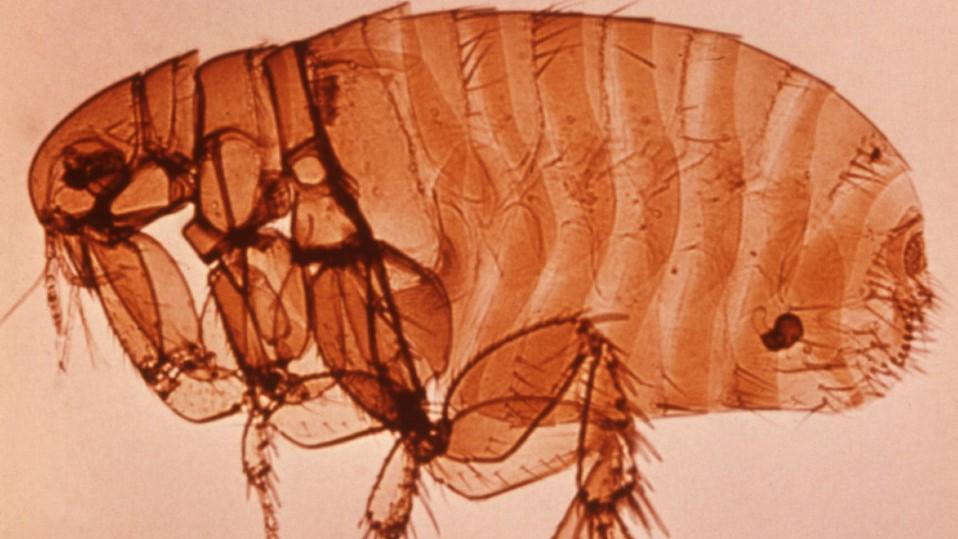Beware! Flea Season Isn't Over Yet!

- posted: Sep. 01, 2019
Beware! Flea Season Isn’t Over Yet
Fleas are quite the nuisance and can cause skin irritation and other more serious diseases in our pets, not to mention the “ick” factor they carry and the fact that they can be difficult to evict from our homes once they invade. There are a variety of good flea and tick preventatives that can be used to keep fleas at bay. Let’s learn more about fleas!
The most common type of flea on both cats, dogs and other mammals is the cat flea Ctenocephalades felis. Freaky flea facts: it is estimated that fleas have been on earth for the past 100 million years, fleas can jump horizontally about 12 inches—pretty far considering they are on average only 1/10 of an inch long--and a single female flea can lay 50 eggs per day. Fleas can live up to 100 days so that’s potentially 5,000 eggs laid every 3 months and, well, that’s too many newly hatched fleas to even ponder.
The flea life cycle takes about 2-4 weeks to complete. The adult flea lives on the host animal but the eggs laid fall off into the environment. Within about 5 days, eggs hatch into larvae which feed off digested blood (flea poop, mmm) and debris in carpet, bedding and other places in the home. In about 1-2 weeks, the larvae become encased in a pupa which is like a very hard-shelled cocoon, impervious to chemicals and able to withstand a variety of environmental conditions. Adult fleas typically emerge from pupae in 1-2 weeks, but may remain dormant for up to 4 months. New adult fleas immediately feed on blood starting the process over again.
Sometimes, fleas cause few signs, but most pets become itchy and some develop severe allergic reactions with red skin, hair loss at the tail base and rump and constant scratching. Fleas can also cause anemia (due to blood loss) in very young or frail pets or infectious diseases such as bartonella, also known as cat scratch disease which can also affect humans. “Bring out your dead!”--fleas continue to carry bubonic plague--yep, THAT bubonic plague--in some parts of the United States which can infect both cats and humans (bonus points if you got the Monty Python reference!). Pets can also acquire tapeworms from accidentally ingesting fleas when grooming. Juvenile tapeworms can hatch in the flea’s gut and be transmitted to mammals when the flea is swallowed.
Ideally, flea prevention should be administered year-round to every pet in the household. Our goal is to prevent flea problems, not try to control them once they occur. We seem to be experiencing warmer winters and fleas can remain active in temperatures below 50 degrees. If they’ve already infested a home, they will remain active in a stable environment. Do NOT stop flea preventatives in the fall, continue to use them year-round to ensure non-stop protection. Unfortunately, natural products are not reliable forms of flea control and some may be harmful to pets. Garlic, long touted as a natural flea repellent, can cause a form of anemia in dogs and cats and essential oils like tea-tree oil and pennyroyal oil may repel fleas, but they can also be toxic to pets. For solid flea control advice, stick to tried and true drugs that are available (topicals, chewable pills and collars) and talk to your vet about the best product for your pet. Also, remember, NEVER, EVER, apply a flea control product labeled for dogs to a cat. Some flea products that are OK for dogs are extremely toxic to cats so read labels carefully before use. There’s also no real reason to use flea powders, sprays or dips on our pets anymore. Flea preventative technology has come a long way and is much more effective than these older methods.
Keep your pets flea-free all year with proper preventatives. If the nasty buggers have somehow already found their way onto your dog or cat, contact us for advice on how to boot them out for good!
This blog brought to you by the Patton Veterinary Hospital serving Red Lion, York and the surrounding communities.
https://www.petmd.com/dog/general-health/evr_multi_10facts_about_fleas
Location
Patton Veterinary Hospital
425 E Broadway
Red Lion, PA 17356
